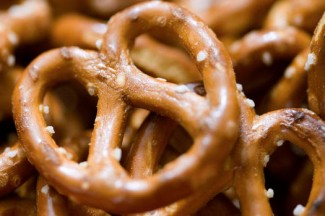 Pretzels come in many flavors, shapes, and sizes — not unlike us. These treats are great for cheese or other dips or just by themselves. But have you stopped to consider they actually have a historical place in Lent?
Pretzels come in many flavors, shapes, and sizes — not unlike us. These treats are great for cheese or other dips or just by themselves. But have you stopped to consider they actually have a historical place in Lent?
If you take a moment to look at the typical twist pretzel, you can see that it is a model of the common prayer position from the early 600s of folding your arms over each other on your chest and putting your hands on your shoulders.
Pretzels were developed as an option to satisfy abstinence and fasting laws of the time. Eggs, fat, and milk were forbidden during Lent. So, the remaining ingredients that one could use included water, flour, and salt. A young monk baked the first pretzel — making a Lenten bread of water, flour, and salt, forming the dough into the prayer position of the day and baking it as soft bread. These first pretzels would have been much like the soft pretzels we have today.
Greg Dues, in his book “Catholic Customs and Traditions,” explains more of the pretzel history:
“These little breads were shaped in the form of arms crossed in prayer and were called bracellae (Latin, ‘little arms’). Among the Germans the word became ‘bretzel’. These pretzels were a common Lenten food throughout the Middle Ages in Europe, and became an all year round snack, in its original shape only in the last (19th) century.”
The suggestion of arms crossed in the form of prayer may have led to pretzels being given as a reward to young children when they could recite their prayers. Pretiola means little reward, which could also be a derivative of the term pretzel. The three holes in a pretzel are also said to represent the Holy Trinity.
After their invention, pretzels became a symbol of good luck, long life, and prosperity. They were commonly given to the poor and hungry. The legend of the hard pretzels that we snack on today tells of an apprentice baker who fell asleep while preparing pretzels and let the fire begin to die out. When he noticed, he restarted the fire, but the result was overcooked pretzels. The surprise was a tasty treat that was less perishable than the soft pretzels and easy to have available to give to those in need.
Food has long played a role in our faith, especially during Lent. We abstain from certain foods, such as meat, and spend time fasting. This practice can provide us with a deeper religious experience by joining us with people throughout the world who struggle to survive. Fasting is an opportunity to be in solidarity with those who experience physical and spiritual hunger.
RELATED: Why Do We Give up Something for Lent?
Pretzel twist
When the monk first baked pretzels so long ago, I don’t think he could have imagined all of the different types and flavors that we have today. There are roasted garlic, Italian herb, parmesan, and butter pretzels. Auntie Anne’s makes a seaweed-flavored pretzel in Singapore and a banana-flavored pretzel in the UK. Even a flavor of M&M’s includes pretzels inside their candy-coated exteriors.
I had no idea that pretzels were a Lenten food. Through the years, I’ve spent time trying to understand the importance of Lent and trying to remember not to eat meat on Fridays. I admit, some years I’m more successful than others. Yet I can see how pretzels tie into Lent in a spiritual way. In the life of a faithful person, there are many times you may feel twisted up inside, struggling with your beliefs or dealing with frustrations. But if you take a look at a typical twist pretzel, remember its origins in Lent, and move into a position of prayer (spiritually or physically), you are exactly in the position you need to be in when you feel twisted up inside.
Make pretzels part of your Lenten tradition this year. Here’s a pretzel recipe to try. Bake them (or buy your favorite kind), grab a beer, and remember the faith-pretzel connection this Lent.
Previously published: March 2012